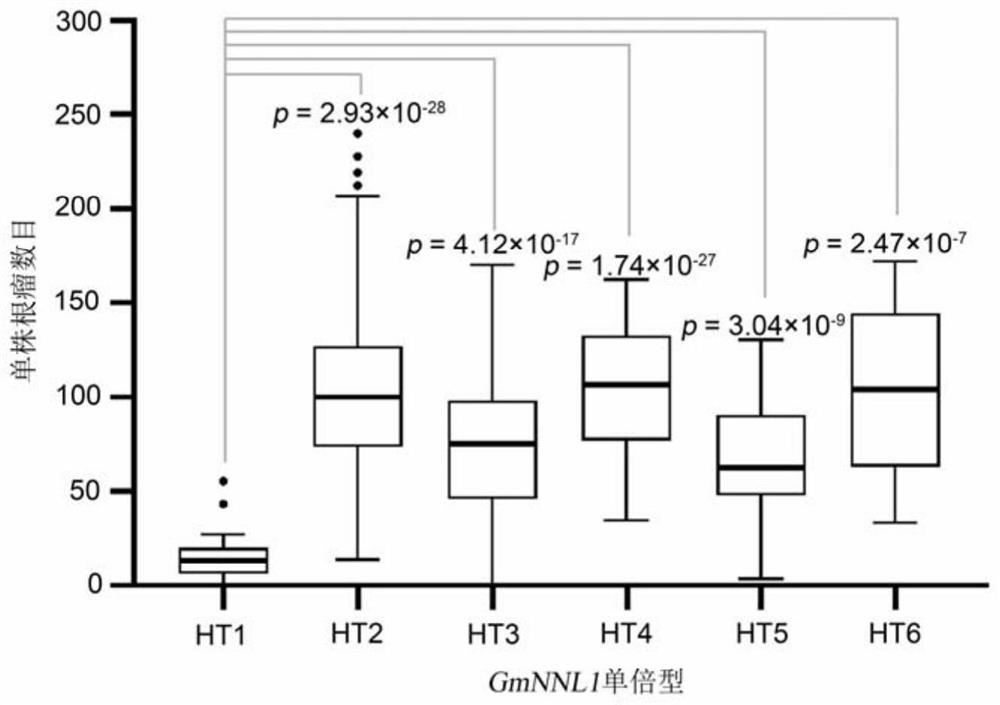R gene for controlling soybean-rhizobium matching property as well as protein and application thereof
A rhizobia and matching technology, applied in application, genetic engineering, plant genetic improvement, etc., to achieve the effect of improving symbiotic nitrogen fixation ability
- Summary
- Abstract
- Description
- Claims
- Application Information
AI Technical Summary
Problems solved by technology
Method used
Image
Examples
Embodiment 1
[0027]The present application constructs the core germplasm of cultivation soybeans. It is a method of simultaneously affecting the number of soybean roots in soybeans, a single biovistribution of soybean roots, and GMNNL1. Through haplotype analysis, the six major haplotypes of GMNNL1 were found, only GMNNL1HT1 (Sequence, such as SEQ ID NO.1) can be normally encoded into a typical R protein of TIR-NBS-LRR, other five haplotypes (sequences such as SEQID No. 4, SEQ ID NO.5, SEQ ID No.6, SEQ ID NO. 7 or SEQ ID NO.8) Both the insertion of a transposon GMSine1 or the deletion of a single base results in a non-intact protein form (figure 1 ). Through haplotype analysis, it has GMNNL1HT1 The number of root tumors of haplotype soy is significantly lower than other haplotypes (Fig. 2), by comparing the complete form of the R protein structure, GMNNL1HT1 And non-complete forms of GMNNL1HT2-HT6 , Found with GMNNL1HT1 Single-type soybean monitase activity and ground parts are significantly low...
Embodiment 2
[0032]The gene sequence of GMNNL1 is obtained by the following method:
[0033]The total volume of the reaction system is 50 μl, and the template is a soybean-stranded peony-peat-generator DNA 1 μL (about 50 ng), 10 × KOD enzyme reaction buffer 5 μL, 25mm mgCl2 2 μL, 5 mM DNTP 5 μL, 5 μL of 5 μL (primers NNL1-F and NNL1-R, each primer is 2.5 μL), 1 μl of KOD enzyme, DDH2O (sterile peeled water) to 50 μL. The reaction procedure was: 94 ° C degeneration 5 min, 94 ° C 30s, 55 ° C for 1 min, 68 ° C 3.5 min 35 cycles, and extends at 68 ° C for 10 min. The primers were: NNL1-F: atggcacagaacagcaccatct; NNL1-R: TcatttaAcaactagtacaaac; finally obtained gene sequence containing the nucleotide of SEQ IDNO.2, which encoded the protein as shown in SEQ ID NO.3.
[0034]The protective content of the present invention further includes a nucleotide sequence corresponding to the amino acid sequence shown in SEQ ID NO. And also includes sequences shown in SEQ ID NO to pass through the modified protein havin...
Embodiment 3
[0036]Gmnnl1 genes are used in regulating soy-rhizobium, and the application process is as follows:
[0037]The promoter and full length CDS of Gmnnl1 in HFWD were cloned to the PUB-GFP, transfer to Williams82 (WS82, GMNNL1)HT2 In the obtained transgenic system, USDA110 is inoculated, GMNNL1HT1 The higher the expression quantity, the less the number of root tumors (Fig. 6). Therefore, the tumor of a particular type of rhizobium can therefore be reduced by this method. The specific process is:
[0038](1) The GMNNL1 promoter region is obtained by:
[0039]The total volume of the reaction system is 50 μl, and the template is a cross-pem-bean genome DNA 1 μL (about 50 ng), 1 × KOD enzyme reaction buffer 5 μL, 25mm mgCl2 2 μL, 5 mM DNTP 5 μL, 5UM primer 5 μL (primers PNNL1-F and PNNL1-R 2.5 μL), 1 μl of KOD enzyme, DDH2O (sterile peeled water) to 50 μL. The reaction procedure was: 94 ° C degeneration 5 min, 94 ° C 30s, 55 ° C 1 min, 68 ° C 2 min 35 cycles, and 68 ° C extends for 10 min. The prim...
PUM
 Login to View More
Login to View More Abstract
Description
Claims
Application Information
 Login to View More
Login to View More - Generate Ideas
- Intellectual Property
- Life Sciences
- Materials
- Tech Scout
- Unparalleled Data Quality
- Higher Quality Content
- 60% Fewer Hallucinations
Browse by: Latest US Patents, China's latest patents, Technical Efficacy Thesaurus, Application Domain, Technology Topic, Popular Technical Reports.
© 2025 PatSnap. All rights reserved.Legal|Privacy policy|Modern Slavery Act Transparency Statement|Sitemap|About US| Contact US: help@patsnap.com



